


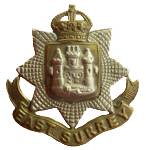
25979, Private, James MATTHEWS
Aged 23

East Surrey Regiment, 8th Battalion
formerly 35692 Essex Regiment
Killed in Action on Friday 12th October 1917
|
Born in Lakenheath (Mildenhall Q1-1894 4A:803)
1901 census...Aged 7, he was living at High Street, Lakenheath with his father-James MATTHWEWS [38] stoneshifter; mother- Mary Ann Gayton (née TAYLOR) [40]; sister- Elizabeth [15] and brother- William J [8]. All were born in Lakenheath. 1911 census... Aged 16, farm labourer, he was living in Half Moon Lane, Lakenheath with his parents and brother William. 2 out of 5 children had died. |

|
Enlisted in Bury St Edmunds. |
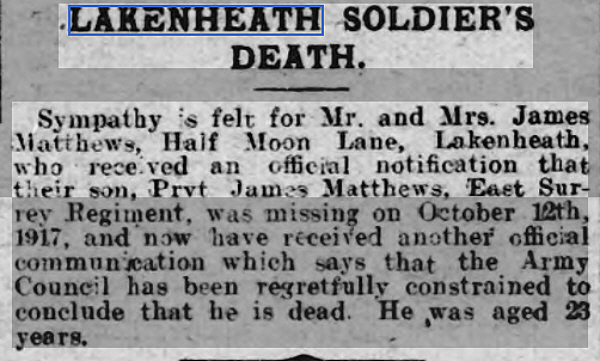
|
Part of the horrific 3rd Battle of Ypres, usually known as Passchendaele, on 12th October 1917 the battalion were near Poelcappelle, NE of Ypres. From the history of the East Surrey Regiment we have :- Captain K. Bell-Irving was to lay out the forming-up tape from Gloucester Farm to Terrier Farm. This was no easy task and took several hours to carry out, but it was completed at last, in spite of the tape being broken several times by shell fire. The dispositions for attack were as follows: B and C were right and left assaulting companies, with the road running south-east from Meunier House as their objective. A and D Companies were to "leap-frog" B and C and take the Papa Farm-Hinton Farm Ridge. As, however, the operation orders were again altered at the last moment, few if any of the officers and other ranks had a clear idea of what was expected of them. About midnight, Major Place, who had been visiting the platoons, came to Battalion Headquarters and reported that he had been unable to find No. 5 platoon, under 2nd Lieut. N. L. Riddett. Lieut.-Colonel Irwin went out with him, but could find no trace of them, nor was anything known of them until they were seen next morning getting up and going forward under our barrage. 2nd Lieut. Riddett set a very gallant example. He had had no orders and did not even know at what time the attack was to be made, but he did know that he could not do wrong if he went forward with the barrage. Shortly after midnight the enemy shelled the sector held by the Battalion with "mustard gas." Respirators were put on, and there were no ill effects except a few blisters. At about 4 a.m. on October 12th, while moving his company up into position, 2nd Lieut. R. S. Franks, commanding D Company, was killed by a shell. He was a very promising officer, full of energy and high spirits, and much liked. His death was a great loss to the Battalion. Shortly afterwards 2nd Lieut. C. A. Heath, of D Company, was wounded, and the command of the company fell on 2nd Lieut. C. Whyntie, who was severely wounded at the moment of advance, so that the company went into action without any officers. Zero hour was at 5.35a.m., but the barrage opened in an irregular way, commencing at zero minus four minutes. It was not sufficiently heavy, and, although it only moved at the rate of fifty yards in four minutes, the state of the ground was such that the men with ordinary equipment could not keep up with it, while those carrying the Lewis guns and their ammunition bags could not advance at all, as they sank too deep in the mud. Moreover, the barrage opened too far in front of our line, leaving untouched several enemy machine-gun posts between it and our front line. Heavy machine-gun and rifle fire was opened by the enemy all along our front and continued throughout the action. Shortly after zero, Lieut. G. A. G. Wix and 2nd Lieuts. H. Fearn and N. L. Riddett were killed by machine-gun fire, and Captain C. R. Holms, commanding A Company, was severely wounded. Captain G. A. Birnie (R.A.M.C.) and 2nd Lieut. H. S. Todd, of C Company, were also wounded. The enemy barrage, which came down at zero plus four minutes, was not heavy, but consisted of shells of large calibre. At about 8.30 a.m., Major C. G. Place, commanding B Company, returned wounded to Battalion Headquarters and reported that some of our men had advanced 500 yards or more, but that they had passed several machine-gun posts which were still holding out. In particular a post with two machine guns about 100 yards east of Gloucester Farm caused a large number of casualties. All the men who passed these machine-gun posts were eventually killed or taken prisoners. The situation was very obscure for some time, as all the officers except three and a large number of the N.C.O.'s had become casualties, and also from the fact that no runners could get back over that open ground owing to rifle and machine-gun fire. The mud was so bad that rapid movement from shell hole to shell hole was impossible, and most of the casualties among officers and N.C.O.'s were incurred in attempting to lead advances by short rushes after the barrage had been lost. The rifles and the men's hands were plastered with mud, so that each time that a fresh clip was inserted some mud went into the magazine with it, and the breach had to be cleaned after every few rounds. By degrees it became evident that, in spite of all its sacrifices, the Battalion had made but little way, and under the existing conditions of weather and ground could make no further advance. The Commanding Officer, therefore, sent a message to Brigade Headquarters, asking permission to reorganize his line in the evening 100 yards in front of the forming-up tape. This he proposed in order to have some definite mark as a guide, for there were no natural features suitable to the purpose. At about 2p.m. the Brigade Major, Captain C. Runge, arrived at Battalion Headquarters and told Lieut.-Colonel Irwin that the Battalion might perhaps be relieved at night, but that this was still uncertain. No relief, in fact, took place, and in the evening Lieut.-Colonel Irwin reorganized his posts as he had proposed, and got in touch with "The Buffs" on his left and with a battalion of the 9th Division on his right. The 6th Battn. Royal Berkshire Regt. also had formed up at a short distance in rear and was digging itself in there. The unsatisfactory position of Battalion Headquarters has been mentioned, and search was made for a better place, but none could be found. During the night the headquarters was persistently shelled, and at 2.30a.m. on October I3th received a direct hit on one end, which killed 5 and wounded 2 of the personnel. Finding at 4a.m. that no orders for relief had arrived, Lieut.-Colonel Irwin communicated with Brigade Headquarters, and at 8a.m. received orders (timed 8.50p.m. the previous night) authorizing him to withdraw all men not required for his new line of posts to Gournier Farm. As it was now broad daylight, it was impossible to make any movement from the front line. Soon afterwards orders were received that the Battalion would be relieved at night by the 7th Battn. " Queen's," and at 5.30p.m. the relief was duly commenced, but took very long to complete. It was not, in fact, till 5.30a.m. on October I4th that the last platoon of the Battalion had reached Canal Bank Baths, near Boesinghe, three and a half miles north of Ypres, where all bathed, changed their underclothing and had a hot breakfast. At 1.45p.m. lorries conveyed the Battalion back to its quarters at Dirty Bucket Camp, near Vlamertinghe, whence it had gone up to the front line on the l0th. The 8th Surreys lost 92 killed on 12th October 1917, 18 have identified graves, 74 are named on the Tyne Cot Memorial |
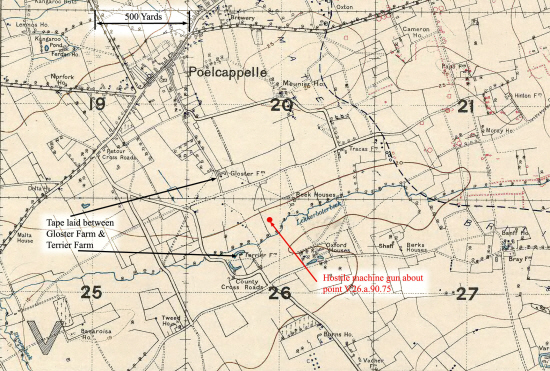
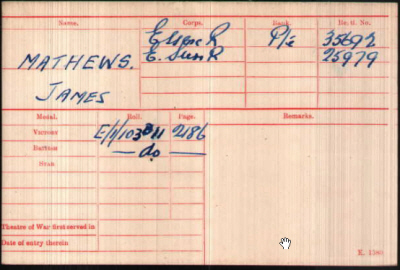
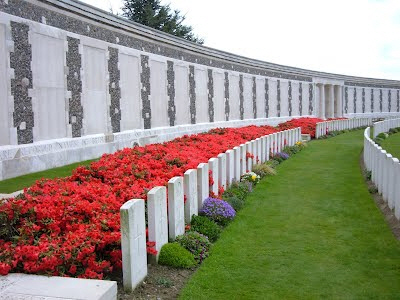
click here to go to the Commonwealth War Graves
Commission website for full cemetery/memorial details